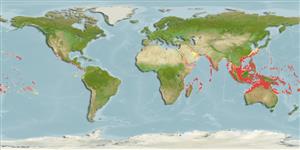>
Acanthuriformes (Surgeonfishes) >
Chaetodontidae (Butterflyfishes)
Etymology: Heniochus: Greek, enioi, -ai, -a = sometimes, some + Greek, oche = food (Ref. 45335).
More on authors: Smith & Radcliffe.
Environment: milieu / climate zone / depth range / distribution range
Écologie
marin récifal; profondeur 2 - 250 m (Ref. 90102), usually 15 - 40 m (Ref. 9710). Tropical; 32°N - 23°S
Pacific Ocean: Andaman Islands in the eastern Indian Ocean to Samoa, north to southern Japan, south to Rowley Shoals and New Caledonia.
Taille / Poids / Âge
Maturity: Lm ? range ? - ? cm
Max length : 30.0 cm TL mâle / non sexé; (Ref. 48636)
Épines dorsales (Total): 11 - 12; Rayons mous dorsaux (Total): 25-27; Épines anales 3; Rayons mous anaux: 17 - 18.
An uncommon species (Ref. 9710) that inhabits deep lagoon and seaward reefs. Adults solitary or in small groups and prefer areas with rich coral growth and high vertical relief (Ref. 1602). Juveniles solitary and secretive on inshore reefs. Largest of the bannerfishes (Ref. 48636). Feed on coral polyps (Ref. 9710). Oviparous (Ref. 205). Form pairs during breeding (Ref. 205).
Life cycle and mating behavior
Maturité | Reproduction | Frai | Œufs | Fécondité | Larves
Form pairs during breeding (Ref. 205).
Randall, J.E., G.R. Allen and R.C. Steene, 1990. Fishes of the Great Barrier Reef and Coral Sea. University of Hawaii Press, Honolulu, Hawaii. 506 p. (Ref. 2334)
Statut dans la liste rouge de l'IUCN (Ref. 130435)
Menace pour l'homme
Harmless
Utilisations par l'homme
Pêcheries: intérêt commercial mineur; Aquarium: Commercial
Plus d'informations
RéférencesAquacultureProfil d'aquacultureSouchesGénétiqueElectrophoresesHéritabilitéPathologiesTraitementNutrientsMass conversion
Outils
Articles particuliers
Télécharger en XML
Sources Internet
Estimates based on models
Preferred temperature (Ref.
123201): 25 - 29, mean 28.1 °C (based on 840 cells).
Phylogenetic diversity index (Ref.
82804): PD
50 = 0.5039 [Uniqueness, from 0.5 = low to 2.0 = high].
Bayesian length-weight: a=0.02239 (0.01117 - 0.04486), b=3.02 (2.85 - 3.19), in cm total length, based on LWR estimates for this (Sub)family-body shape (Ref.
93245).
Niveau trophique (Ref.
69278): 3.6 ±0.44 se; based on food items.
Résilience (Ref.
120179): Haut, temps minimum de doublement de population inférieur à 15 mois (Preliminary K or Fecundity.).
Fishing Vulnerability (Ref.
59153): Low vulnerability (20 of 100).
Nutrients (Ref.
124155): Calcium = 56.1 [28.3, 91.8] mg/100g; Iron = 0.628 [0.373, 1.013] mg/100g; Protein = 18.7 [17.6, 19.9] %; Omega3 = 0.138 [0.083, 0.228] g/100g; Selenium = 48.2 [26.8, 87.9] μg/100g; VitaminA = 45.8 [13.1, 156.3] μg/100g; Zinc = 0.996 [0.682, 1.426] mg/100g (wet weight);
